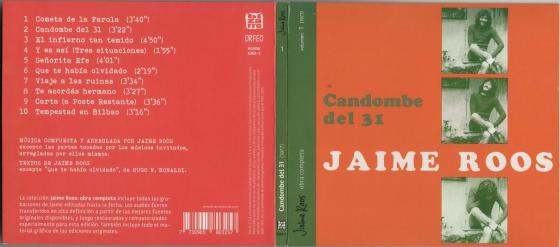[UPDATE on 7/26/18: All 13 volumes released so far are available on Spotify and other digital platforms.]
Unless you’re from Uruguay or Argentina, chances are you have no clue as to who Jaime Roos is. I won’t bore you with ultimately unimportant biographical details, but here’s a story I wrote about him years ago.
To make it quick and painless: Jaime Roos is one of the most successful and influential musicians (at least in neighboring countries) to ever come out of Uruguay and, if you’re into World Music in general (and Latin alternative/popular music in particular) you absolutely must find a way to obtain his Obra Completa series. As stated in the series itself:
“The collection Jaime Roos: obra completa includes all of the artist’s recordings to date. The audio has been transferred in high definition from the best available sources, then restored and remastered especially for this edition. It also includes all the graphic material from the original releases.”
That’s the good news. The bad news is that, as of today, the only way you can get these masterpieces is through a friend in Uruguay or Argentina, and there are no plans to ever have these albums available on digital platforms (that’s the whole point of the collection; you want to have the original art and info).
Uruguay’s Bizarro label is behind this mammoth project (from material originally released mostly by Ayuí and Orfeo), and in this blog you’ll have samples from each record (using original sound, not the remastered sound available in Obra Completa) and full translation of the Spanish liner notes for each album, specifically written for this collection by Brazilian musicologist and author Guilherme de Alencar Pinto.
Keep in mind Uruguay is a country with a population of a little more than 3 million (even less when Jaime started making music), so the meager sales figures mentioned in this blog are huge by Uruguayan standards (at one point, Jaime would become the best-selling local solo artist in the country’s history).
I will update the blog as new batches of CDs are released, and whenever I feel I want (and have the time) to add more of my own commentary for each album (so keep checking back for updates). Within the liner notes, you’ll find brackets with my own text, which I added for clarification. But I tried to respect the superb original notes by Guilherme as much as I could. Most of all, Jaime’s eclectic, timeless music should speak for itself. Listen loudly as you read.
My only reservation with this collection is that Jaime opted to release the albums chronologically, which means sometimes collaborations, live albums and rarities come before his albums of original material. No biggie. I’m just an impatient guy.
So here we go, starting with…
Candombe del 31 (1977)
“Cometa de La Farola” is an early murga-song Jaime wrote while in Amsterdam, after receiving a newspaper clip from his father informing him that his beloved soccer team, Defensor, had won the Uruguayan tournament in 1976. It was the first time a “small” team won the tournament since the beginning of Uruguay’s professional era in 1932. Overcome by emotion, Jaime wrote what he once considered “a children’s song.” Years later, he would record an alternate version of it. Here’s the original:
And here, in my opinion, is one of the best (if not the best) candombe performances on guitar ever.
Complete liner notes by Brazilian musicologist, critic and author Guilherme de Alencar Pinto:
“On September 13, 1975, Jaime Roos got on a plane on his way to Madrid. The main pretext was a series of performances with Patria Libre, the Latin American folk music group he was a member of. His deeper motivation was to travel the world while escaping the oppressive climate of Uruguay, which had succumbed to a [military] dictatorship since 1973. Jaime was 21 and had worked professionally as an instrumentalist since age 16. He had written the music for a play in addition to four songs, only one of which (the 1973 ballad ‘Hoy’) had been performed live by Epílogo de Sueños, where Jaime was the bassist. But it was in Europe where Jaime finally developed as a composer, especially in December, when he moved to Paris and embarked on a personal artistic project he hadn’t foreseen until then.
In August 1976 he selected four of the songs he had finished and recorded a demo at Adam Studio in Roissy-en-Brie, a Paris suburb. Lacking alternatives, he played all the instruments, not devoid of a certain fascination for exploring the possibilities of multi-track recording and testing himself, albeit unofficially, as a one-man orchestra. Except for the bass, all the instruments were loaned to him. Because he couldn’t pay more than a few hours of studio time, both the recording and the mix were done almost without retouches.
Soon after, Jaime and his girlfriend — the Dutch Franca Aerts — went to Mexico with a plan: to hitchhike through Latin America and visit Uruguay, where they finally arrived in December 1976. In Montevideo, Jaime showed the recordings to Coriún Aharonián, co-founder and head of the Ayuí label, who immediately proposed to him an LP. Coriún figured those demos sounded better than anything that could be produced in Uruguayan studios, and decided to include them in the album. In retrospect, those four French recordings are the least ‘professional’ in all of Jaime’s discography, but their existence made it possible to finish the album recording only six additional songs, despite Ayuí’s tight budget. Four of them had been completed after the making of the demo (‘Viaje a las ruinas’ and ‘Carta [a Poste Restante]’ reflect the Latin American trip). To complete six, Jaime used ‘Te acordás hermano’ — the only pre-Europe song that made it onto the record — and specifically wrote ‘Y es así.’
At Sondor studios, Jaime had even less hours than in Paris (and more songs to record), but he chose simpler arrangements. Besides, he had guests: Jorge Bonaldi and Jorge Lazaroff, his buddies in projects like Patria Libre and Aguaragua; Luis Sosa (legendary drummer and former member of El Kinto) had shared with Jaime works for the stage and TV, and that’s how this candombe-beat pioneer also played in the first murga-beat: ‘Cometa de la farola.
The first batch of the LP was printed in a hurry (to coincide with the series of release shows in April and May of 1977) and its cover didn’t please those who had designed it. For the next batch, the colors were corrected, and this is the version utilized on the cover of the present edition.
Jaime returned to Europe immediately following those shows. Candombe del 31 sold a little more than 100 copies in its first two years of existence. Later, the increasing repercussion of his following albums fed the curiosity for this first work, which became a cult album and sold a little more than 1,000 copies on vinyl and cassette. This is the first complete CD release.”
Go to the next page to read/hear about 1978’s Para espantar el sueño.



Enrique – saludos desde Irlanda. Thank you for these blogs about Jaime Roos’ music. I am a great admirer of this soulful, honest and important music from a beautiful and soulful country. I didn’t know if the 4 CDs in the new batch are the same quality as the first sets, your blogs have corrected that for me.
I did buy some in Montevideo but have also been able to find them also on Amazon (muy, muy caro) or ebay (mejor precio).
Do you know why “Brindis Por Pierrot” has not been released as a standalone disc or am I missing something?
Gracias por su trabajo, Simon Leng
LikeLike
OK, Guilherme explains this clearly in his commentary to Selladas Uno, but here’s a quick summary: The ‘Brindis por Pierrot’ album only included three new songs: “Brindis por Pierrot,” “Murga de la Pica” and the new version of “Cometa de la Farola.” The other six songs had already been released on other albums. ‘Selladas Uno’ includes these three songs.
The ‘Brindis por Pierrot’ album is not included in this collection because the idea is not to repeat songs, except in the case of different versions of one song, but not the same version.
These 13 albums only include three “repeat” songs: the Estela Magnone duets included in both the ‘Mujer de sal junto a un hombre vuelto carbón’ and ‘El Puente’ albums.
I hope this clarifies things. Thanks for reading and listening!
LikeLike
Good question! Let me find out… Abrazo.
LikeLike
Thanks, that is great information. Here’s a thought for you…..is “Fuera de Ambiente” Jaime Roos’ masterpiece? To my ears it could be
LikeLike
I love ‘Fuera de Ambiente,’ but I’m not sure if it’s his masterpiece. Definitely one of his best, and unfairly underrated. It’s his only album of originals with no solos. Everything is written down. Beautiful songs. When I saw him live for the last time in 2007, my mother was on her deathbed and he kindly dedicated “Catalina” to her. I think his first masterpiece is ‘Aquello’, but I also love ‘Siempre son las cuatro’, ‘Mediocampo’ and ‘Estamos rodeados’. And ‘La Margarita’ too. But I love them all. I’m a diehard fan.
LikeLike
I look forward to hearing the next set of 4 which I ordered for a reasonable price on amazon, so they are available globally. I especially like “Vida Numero Dos” which I think is a profound piece and captures many different musical elements…some of which I have written about:
I am pro-Uruguay so probably biased but as well as great soccer players and teams the country has produced some really world class music with Opa, Ruben Rada and Jaime Roos leading the pack. Outstanding musicians.
Best wishes…
LikeLike
So… What’s your story with Uruguay? Are you English?
LikeLike
It’s a “camino largo” ; )
Email me if you like simon,leng@gmx.com
LikeLike
comma after simon…?
LikeLike
Disculpa….no. That is a typo. It is simon.leng. ayer recibi the new discs….La Margarita is going to require some study.
LikeLike
Beautiful album. I love it.
LikeLike
Pingback: #94 / NEGRITUD: Recordando a Alfonso López Domínguez | KAMIKAZE
Pingback: # 91 / Spinetta Jade 1982: el reportaje perdido | KAMIKAZE